In today’s fast-paced and demanding professional landscape, the importance of good work culture cannot be overstated. A company’s work culture sets the foundation for its success, influencing employee satisfaction, productivity, and overall organizational performance.
A workplace where collaboration thrives, employees are motivated and supported, and innovation is encouraged. It’s a place where team members genuinely care for one another, fostering a sense of belonging and shared purpose. Good work culture goes beyond the tangible benefits, creating an environment that nurtures individual growth and collective achievement.
Join us as we delve deeper into the elements that define a thriving work culture and uncover the secrets behind its transformative power.
What is a Good Work Culture?
A good work culture encompasses the values, beliefs, behaviors, and practices that shape the overall work environment within an organization. A company’s collective personality influences its employees’ attitudes and actions. A strong work culture promotes a positive and supportive atmosphere where individuals can personally and professionally thrive.
In a good work culture, communication is open and transparent. Employees feel comfortable expressing their ideas, concerns, and feedback, knowing their voices are heard and valued. Collaboration fosters teamwork and collective problem-solving. Respect, trust, and empathy form the foundation of relationships between colleagues, employees, and management.
Moreover, a good work culture promotes work-life balance, recognizing the importance of personal well-being alongside professional growth. It values diversity and inclusion, creating an environment where individuals from different backgrounds feel welcome and can contribute their unique perspectives.
A good work culture ultimately cultivates employee engagement, motivation, and satisfaction. It nurtures a sense of purpose and belonging, fostering loyalty and commitment among the workforce. When employees are happy and fulfilled, they are more likely to perform at their best, driving the success and growth of the organization as a whole.
What are examples of good company culture?
Good company culture creates an environment of collaboration, respect, and growth, fostering employee satisfaction, productivity, and overall organizational success.
Example 1: At Company XYZ, they prioritize work-life balance by offering flexible work schedules, remote work options, and wellness programs. They also foster a culture of continuous learning and development, providing employees with opportunities for professional growth through mentorship, training, and educational resources.
Example 2: Company ABC promotes a collaborative work culture through open office layouts and regular team-building activities. They prioritize effective communication by encouraging open dialogue, active listening, and constructive feedback. Employees feel empowered to contribute ideas and participate in decision-making processes.
Example 3: Company DEF emphasizes diversity and inclusion by implementing policies and programs that ensure equal employment opportunities. They celebrate different cultures, backgrounds, and perspectives, creating a welcoming and inclusive environment. Employee resource groups and diversity training initiatives further support this culture of inclusivity.
What are the Benefits of a Positive Work Culture?
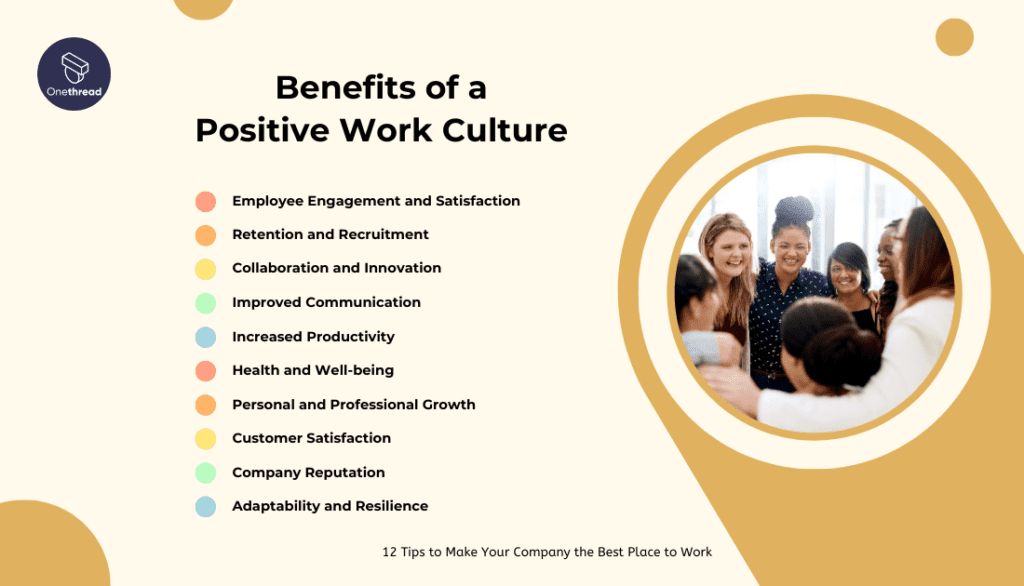
A good work culture brings numerous benefits, including increased employee engagement, retention, productivity, and overall organizational success.
- Employee Engagement and Satisfaction: A good work culture fosters high levels of employee engagement and satisfaction, leading to increased productivity, motivation, and loyalty.
- Retention and Recruitment: A positive work culture attracts top talent and reduces employee turnover, saving recruitment costs and ensuring a stable workforce.
- Collaboration and Innovation: A supportive work culture encourages collaboration, teamwork, and knowledge sharing, fueling innovation and creativity within the organization.
- Improved Communication: A good work culture promotes open and transparent communication, enhancing information flow, reducing conflicts, and fostering strong relationships among team members.
- Increased Productivity: When employees feel valued and supported, they are more likely to be productive, efficient, and focused on achieving organizational goals.
- Health and Well-being: A positive work culture prioritizes employee well-being, leading to reduced stress levels, improved mental health, and overall better physical well-being.
- Personal and Professional Growth: Good work culture provides opportunities for personal and professional development through training programs, mentorship, and career advancement, resulting in higher job satisfaction and growth opportunities.
- Customer Satisfaction: A strong work culture translates into a customer-centric approach, where employees are motivated to deliver exceptional service and ensure customer satisfaction.
- Company Reputation: A positive work culture enhances the company’s reputation, both internally and externally, attracting customers, partners, and investors who value ethical and supportive work environments.
- Adaptability and Resilience: A great work culture promotes adaptability and resilience, enabling the organization to navigate challenges, embrace change, and stay competitive in a rapidly evolving business landscape.
10 Ways to Create a Good Work Culture
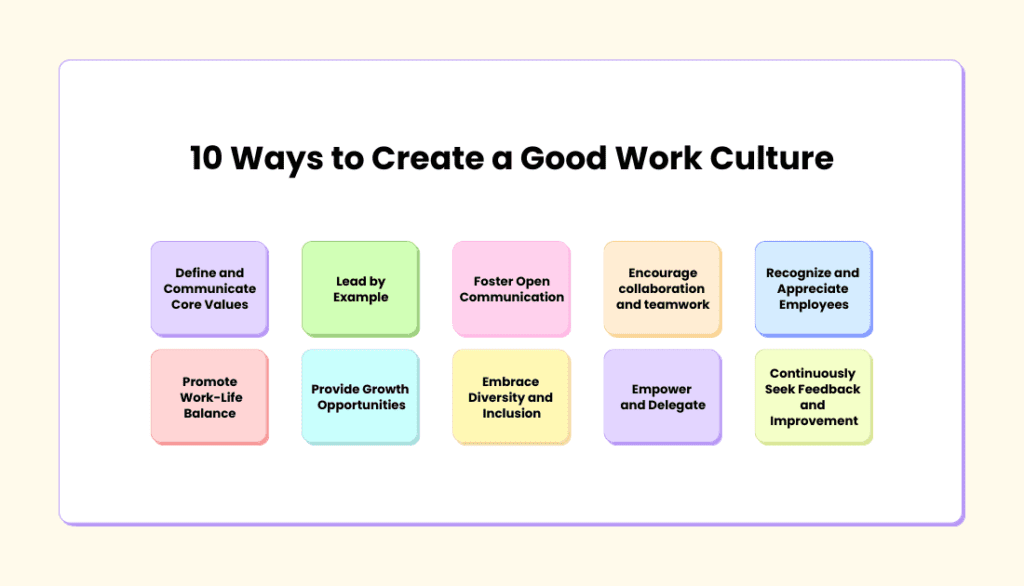
Discover ten powerful strategies to cultivate a positive work culture that promotes collaboration, engagement, and employee well-being.
Define and Communicate Core Values
Establish clear core values that reflect the desired work culture and consistently communicate them to employees.
Lead by Example
Leaders should embody the desired work culture by demonstrating the core values and behaviors they expect from employees.
Foster Open Communication
Encourage transparent and open communication channels where employees feel comfortable sharing ideas, concerns, and feedback without fear of judgment or reprisal.
Encourage collaboration and teamwork
Create collaboration and teamwork opportunities through cross-functional projects, team-building activities, and shared goals.
Recognize and Appreciate Employees
Regularly acknowledge and appreciate employees’ efforts and achievements to reinforce a culture of recognition and gratitude.
Promote Work-Life Balance
Support work-life balance by offering flexible work arrangements and wellness programs and promoting a healthy integration of work and personal life.
Provide Growth Opportunities
Offer professional development programs, mentorship, and training opportunities to support employees’ personal and professional growth.
Embrace Diversity and Inclusion
Foster a diverse and inclusive work environment where all individuals feel respected, valued, and included, and leverage diverse perspectives for innovation and creativity.
Empower and Delegate
Delegate responsibility and empower employees to make decisions, fostering a sense of ownership, autonomy, and trust.
Continuously Seek Feedback and Improvement
Regularly seek feedback from employees and use it to improve policies, procedures, and practices to align with the evolving needs and expectations of the workforce.
12 Tips to Make Your Company the Best Place to Work

Unlock the secrets to creating an exceptional workplace by exploring twelve tips to transform your company into a great place to work:
1. Foster a Positive Work Environment
Create a positive and uplifting atmosphere by promoting a culture of respect, trust, and support. Encourage open communication, celebrate achievements, and address conflicts promptly and fairly.
2. Prioritize Work-Life Balance
Recognize the importance of work-life balance by offering flexible schedules and remote work options and providing resources that promote physical and mental well-being.
3. Invest in Employee Development
Offer continuous learning and development opportunities such as training programs, workshops, and mentorship to support employees’ professional growth and enhance their skill sets.
4. Encourage Collaboration and Teamwork
Foster a collaborative environment by promoting cross-departmental collaboration, team-building activities, and shared goals to encourage teamwork and enhance productivity.
5. Recognize and Reward Performance
Implement a robust recognition and rewards program that acknowledges and appreciates exceptional employee performance, fostering a sense of motivation, engagement, and loyalty.
6. Provide Competitive Compensation and Benefits
Offer competitive salaries, comprehensive benefits packages, and additional perks to attract and retain top talent.
7. Embrace Diversity and Inclusion
Create a diverse and inclusive workplace where individuals from all backgrounds feel valued, respected, and included. Ensure equal opportunities for growth and advancement for all employees.
8. Encourage Innovation and Creativity
Foster a culture of innovation by encouraging employees to think outside the box, share ideas, and provide a platform to implement and experiment with new concepts.
9. Promote Workforce Well-being
Establish programs and initiatives prioritizing employee well-being, such as mental health resources, wellness challenges, and access to fitness facilities.
10. Communicate Transparently
Ensure transparent communication across all levels of the organization, sharing important updates, decisions, and company direction to build trust and foster a sense of belonging.
11. Support Workforce Flexibility
Embrace a flexible work environment that accommodates various work styles and preferences, allowing employees to achieve healthy work-life integration.
12. Cultivate a Strong Company Culture
Develop a unique company culture that reflects the organization’s values and purpose, creating a sense of pride, unity, and shared mission among employees. Regularly reinforce and promote the culture through various initiatives and activities.
Good Company Culture vs. Toxic Company Culture
The table briefly compares good and toxic company cultures based on various parameters. It is important to note that these are generalizations, and company cultures can vary within the spectrum between these two extremes.
| Parameter | Good Company Culture | Toxic Company Culture |
|---|---|---|
| Communication | Open, transparent, and respectful | Lack of transparency, gossip, and poor communication |
| Leadership | Supportive, empowering, and leads by example | Authoritarian, micromanaging, and lack of empathy |
| Collaboration | Encourages teamwork and fosters a sense of unity | Promotes internal competition and siloed departments |
| Trust | Builds trust through honesty and integrity | Distrust, blame culture, and lack of accountability |
| Work-Life Balance | Values work-life balance and employee well-being | Neglects work-life balance and disregards burnout |
| Recognition and Rewards | Recognizes and rewards employee contributions | Favors favoritism and lack of recognition |
| Diversity and Inclusion | Embraces diversity and fosters inclusive environment | Lacks diversity, fosters discrimination and bias |
| Growth and Development | Provides opportunities for growth and development | Stifles growth, limited opportunities, and lack of support |
| Employee Morale | High employee morale and job satisfaction | Low morale, high turnover, and job dissatisfaction |
| Decision-making | Inclusive decision-making process | Top-down decision-making without employee involvement |
| Accountability | Promotes accountability and takes responsibility | Shifts blame, lack of accountability |
| Adaptability | Adapts to change and embraces innovation | Resistant to change and stifles innovation |
How Can Onethread Be Beneficial to Create Good Work Culture?
Onethread can be highly beneficial in creating a good work culture by providing a comprehensive platform that fosters employee communication, collaboration, and engagement.
Here’s how Onethread can contribute to cultivating a positive work environment:
- Enhanced Communication: Onethread offers a centralized communication hub where employees can easily connect, share ideas, and engage in meaningful discussions. It provides transparent and efficient communication channels, promoting open dialogue and reducing communication gaps.
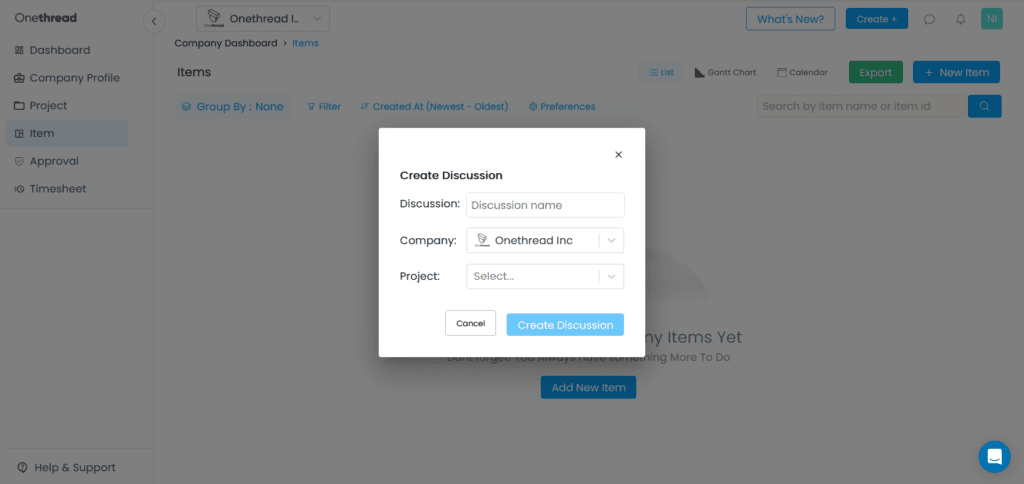
- Collaboration and Knowledge Sharing: With Onethread, employees can collaborate seamlessly on projects, share files, and provide real-time feedback. The platform enables cross-functional collaboration, breaking down silos and encouraging teamwork, innovation, and creativity.
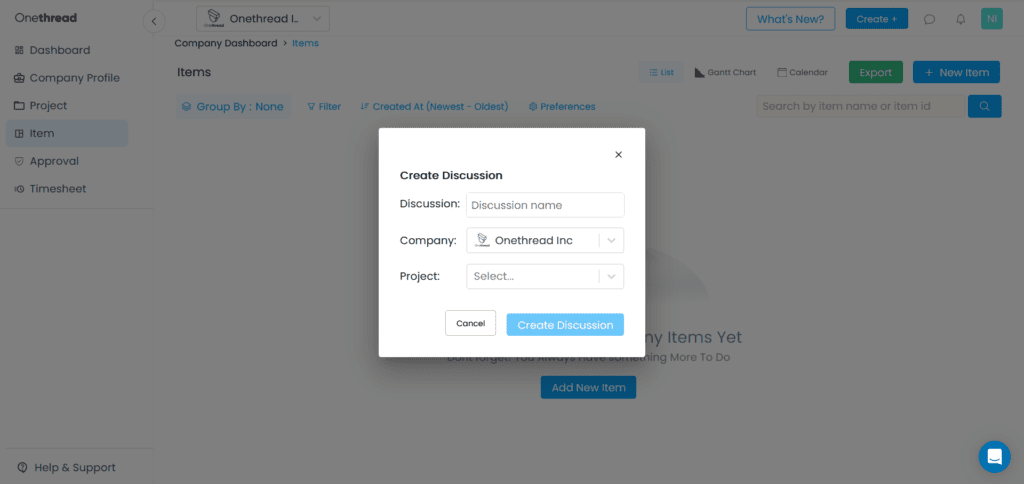
- Recognition and Appreciation: Onethread allows employees to publicly recognize and appreciate their colleagues’ contributions. This feature fosters a culture of recognition and boosts morale, creating a positive and supportive work environment.
- Feedback and Surveys: Onethread provides a platform for conducting surveys, collecting feedback, and soliciting suggestions from employees. This helps leaders understand the pulse of the workforce, address concerns promptly, and make informed decisions to improve the work culture.
- Employee Engagement: Onethread offers various engagement features such as polls, quizzes, and social interactions, promoting a sense of belonging and camaraderie among employees. It helps create a vibrant and interactive community, enhancing overall employee engagement.
- Company-wide Announcements and Updates: Onethread enables leaders to share important announcements, updates, and organizational goals in a centralized and accessible manner. This ensures that employees are well-informed and aligned with the company’s vision and values.
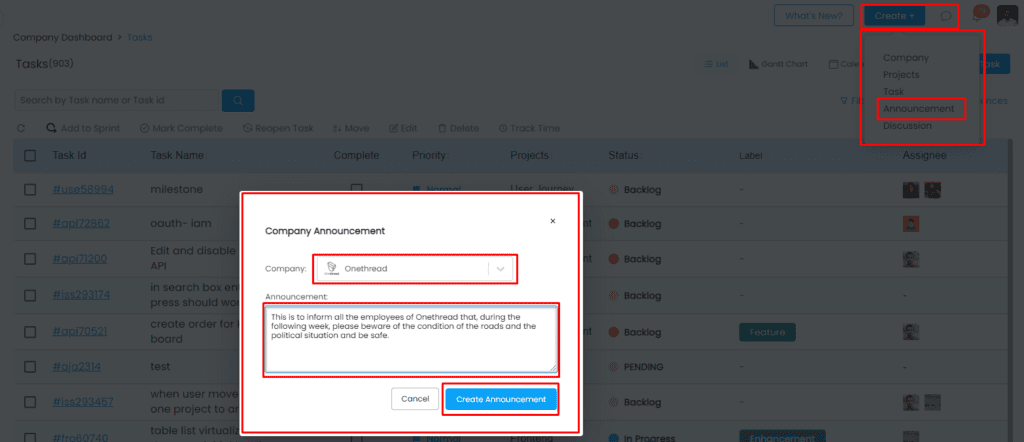
- Learning and Development: Onethread can be utilized to organize and deliver training materials, webinars, and other learning resources. It supports continuous learning and development, enhancing employee skills and promoting organizational growth.

By leveraging the features and capabilities of Onethread, organizations can foster a collaborative, transparent, and inclusive work culture. The platform facilitates effective communication, encourages teamwork, recognizes employee contributions, and promotes employee engagement, ultimately leading to higher productivity, job satisfaction, and overall organizational success.
Final Words
Good work culture is the backbone of a thriving organization. It sets the stage for employee engagement, collaboration, and personal growth. With open communication, recognition, and support, employees feel valued and motivated to excel.
Companies that prioritize work-life balance, diversity, and innovation create an environment where individuals can truly thrive. From fostering a positive atmosphere to embracing change, a good work culture fuels success, nurtures talent, and propels organizations toward a brighter future.
So, let’s strive for a work culture that inspires, empowers, and makes each day a rewarding journey. Try Onethread today to make this transition easy and enjoyable!
FAQ
How do you find a good work culture?
To find a good work culture:
- Look for organizations prioritizing open communication, collaboration, and employee well-being.
- Research the company’s values, mission, and employee testimonials.
- Assess work-life balance, growth opportunities, and diversity and inclusion initiatives.
Interviews and networking can also provide insights into the company’s culture.
Why is culture important?
Culture is important because it shapes an organization’s or society’s collective beliefs, values, and behaviors. It provides a shared identity and a sense of purpose, guides decision-making, influences relationships, and impacts employee satisfaction and performance. A positive culture fosters unity, productivity, innovation, and long-term success.
